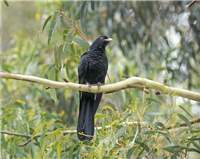Family
Cuculidae
Genus
Eudynamys
Species
scolopacea
Threats/Control Methods - Regional
Free-roaming domestic pets, especially Cats (Felis Catus) may harm young birds in the summer months.
Threats/Control Methods - Local
The land clearing of rainforest areas is the greatest threat to this species, as they are not well adapted to many other environments. This species can cause a threat to local woodland areas by spreading the seeds of weed species.Local/Urban Actions
It is important that gardens are kept free from weed species, especially those bearing fruit. Cat owners can prevent their pets from hunting by installing a cat run or enclosure.Common Names
Common Koel, Cooee Bird, Rain Bird, Storm Bird
Distinguishing Features
This slender species is fairly large at 40-46cm in size. They have long, round tipped tails, thick grey bills and bright red eyes. Male birds have a striking, glossy appearance of blue and green plumage. Females have dark to light brown plumage across their head, body, wings and tail, with white spots throughout. Their underparts are light with darker streaks. Young birds resemble females with brown eyes.
Survey Techniques
Calls are usually the easiest way to detect this species. Some visual identification is also used.
Species Call
Males: a far-carrying, musical 'koo-eel'. Females: shrieking 'quieek-quieek' whistles.
Similar Species
Spanked Drongos (Dicrurus bracteatus) are glossy and dark with an outward curved tail.
Distribution
Within Australia, this species is mostly found along the coastal regions of NSW, QLD and NT. It is seen less commonly further inland from these regions and into VIC. Globally, they are found across India through SE Asia to southern China, Malaysia, Indonesia and Papua New Guinea.
Country of Origin
The birds originally spread from India, however the birds that migrate to Australia are likely to be coming from Papua New Guinea.
Conservation (Pet/Pest) Status - Regional
Low numbers of birds only visit the Canberra region from October to February (COG).
Conservation (Pet/Pest) Status - National
Secure, not listed under the EPBC Act 1999.
LSCCES Population
Three sightings were made in Turner.
Associated vegetation community
Common Koels need warm environments, preferring rainforest and wet eucalypt forest, but also inhabiting farmland, woodland and garden areas.
Limiting Resources
This species requires a warm climate and an abundance of fruit bearing trees and trees with thick, leafy canopies. Successful breeding is dependant on the abundance of the nests of other bird species such as Noisy Friarbirds (Philemon corniculatus ) and Magpie -larks (Grallina cyanoleuca ).
Breeding
Male birds chase females in the breeding season, which takes place from September to February. The Koel will use the active nests of other small birds, including the nests of Figbirds (Sphecotheres viridis), Noisy Friarbirds (Philemon corniculatus ) and Magpie -larks (Grallina cyanoleuca ). The birds lay their one large, pink-cream, spotty egg and remove one of the host's eggs. The Koel egg hatches earlier than the other eggs and then pushes all the other eggs out of nest, taking all the food from the foster parents. The young birds leave the nest after 35 days, then perching on a nearby branch and continuing to demand food from its smaller foster parents.
Behaviour
This species migrates into Australia from Papua New Guinea for the warmer months of October to February. Koels are usually very shy and only call during the summer breeding season, when males are known to make their noisy 'coo-ee' call day and night. Birds are found alone, in pairs or in small groups.
Functional Group
Food Species
The Common Koel will eat a variety of fruits from native or introduced trees and bushes, especially figs (Ficus carica). Some insects and small invertebrates are also eaten from the undersides of leaves, including caterpillars.
Predators
This species is less likely to be prone to attacks from feral or domestic animals due to its large size and preference for high tree canopies. However, Cats (Felis Catus) may attack young birds.
Interesting Fact
The breeding season sends the males into a crazy state, chasing female birds and calling loudly and constantly over day and night.
References - (reader suitability of references, P=Primary teachers, S=Secondary students, T=Tertiary students and researchers)
Books:Morcombe, M. 2000. Field Guide to Australian Birds. Steve Parish Publishing. Archerfield. Australia P, S, T
Pizzey, G. 2000. The Graham Pizzey & Frank Knight Field Guide to the Birds of Australia. Angus & Robertson, Sydney. P, S, T
Veerman, P. 2003. Canberra Birds: A report on the first 21 years of the garden bird survey. Philip Veerman and Canberra Ornithologists Group. Canberra. S, T
Internet: Birds in Backyards. 2006. [online]. Available at:http://www.birdsinbackyards.net P, S, T
Canberra Ornithological Group (COG). 2004. Birds of Canberra Gardens. COG and the ACT Department of Urban Services. [online]. Available at:http://garden.canberrabirds.org.au/ P, S, T
Online Publications: Nix, H. and Cunningham, R. 2006. Birds of the Lower Sullivans Creek Catchment, Canberra ACT. Prepared for the Life in the Suburbs project using data from the Lower Sullivans Creek Catchment Ecological Survey (LSCCES). Australian National University. Canberra. [online]. Available at: http://www.lifeinthesuburbs.com.au/category.php?id=65 S, T


 Top
Top Top
Top